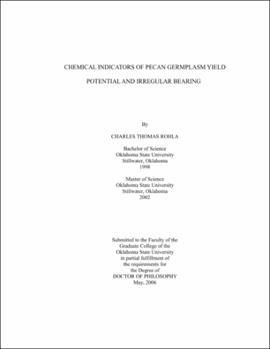| dc.contributor.advisor | Smith, Michael Wayne | |
| dc.contributor.author | Rohla, Charles Thomas | |
| dc.date.accessioned | 2013-12-10T18:04:37Z | |
| dc.date.available | 2013-12-10T18:04:37Z | |
| dc.date.issued | 2006-05 | |
| dc.identifier.uri | https://hdl.handle.net/11244/7744 | |
| dc.description.abstract | Scope and Method of Study: The objectives of the study are (1) to determine if return bloom is inhibited proportionally to mature cluster size, (2) to determine if cultivars with strong alternate bearing tendencies produce larger amounts of kernel per shoot resulting in a greater total energy expenditure than cultivars with a low alternate bearing index, (3) to determine if potassium levels affects carbohydrate synthesis and storage, and (4) to determine if nitrogen levels are associated with irregular bearing tends. | |
| dc.description.abstract | Findings and Conclusions: | |
| dc.description.abstract | The number of shoots that developed the following year was positively related to cluster size for terminal and lateral shoots, but not for shoots with a secondary growth flush. Shoots with a secondary growth flush produced substantially more shoots with larger fruit clusters the next year than the other shoot types. | |
| dc.description.abstract | Organically bound nitrogen and potassium concentration during dormancy in the roots and shoots was not affected by crop load. Carbohydrate concentrations in the roots were not affected by crop load. Shoots that produced a secondary growth flush had a lower carbohydrate concentration than shoots without a secondary growth flush. These data suggest that carbohydrate reserves were not closely related to the current season's crop load nor were they closely related to subsequent flowering. | |
| dc.description.abstract | There were no significant differences among cultivars in non-structural carbohydrates in the roots and the differences in the shoots showed no pattern through the three years of the study. These data suggest that carbohydrate concentration was not related to alternate bearing tendency and that carbohydrate reserves were not triggers of irregular bearing in pecan trees. | |
| dc.format | application/pdf | |
| dc.language | en_US | |
| dc.rights | Copyright is held by the author who has granted the Oklahoma State University Library the non-exclusive right to share this material in its institutional repository. Contact Digital Library Services at lib-dls@okstate.edu or 405-744-9161 for the permission policy on the use, reproduction or distribution of this material. | |
| dc.title | Chemical indicators of pecan germplasm yield potential and irregular bearing | |
| dc.contributor.committeeMember | Martin, Bjorn | |
| dc.contributor.committeeMember | Carvins, Todd | |
| dc.contributor.committeeMember | Maness, Niels O. | |
| osu.filename | Rohla_okstate_0664D_1752 | |
| osu.accesstype | Open Access | |
| dc.type.genre | Dissertation | |
| dc.type.material | Text | |
| thesis.degree.discipline | Crop Science | |
| thesis.degree.grantor | Oklahoma State University | |
